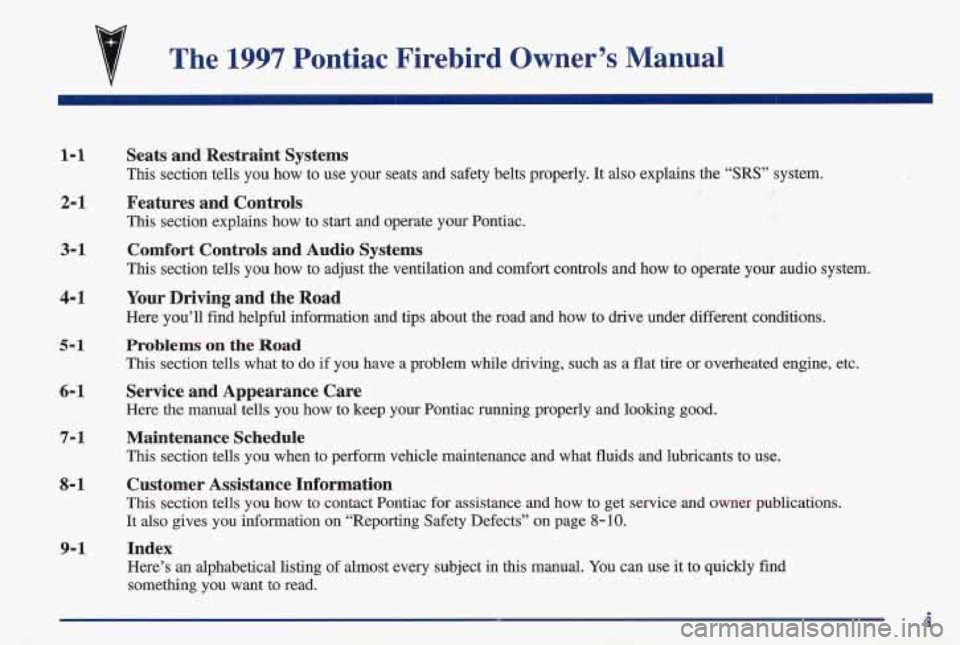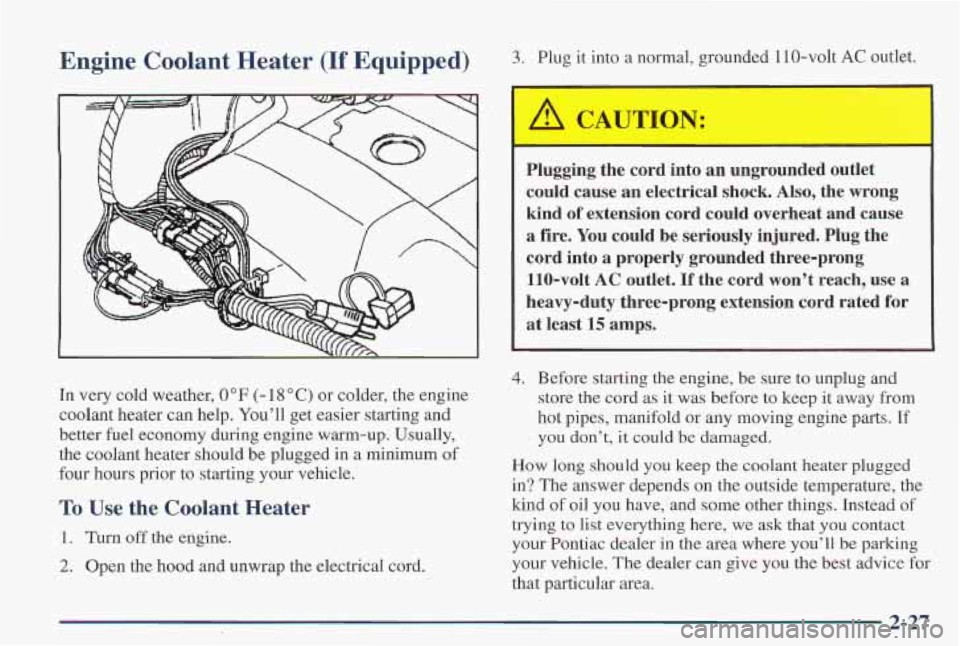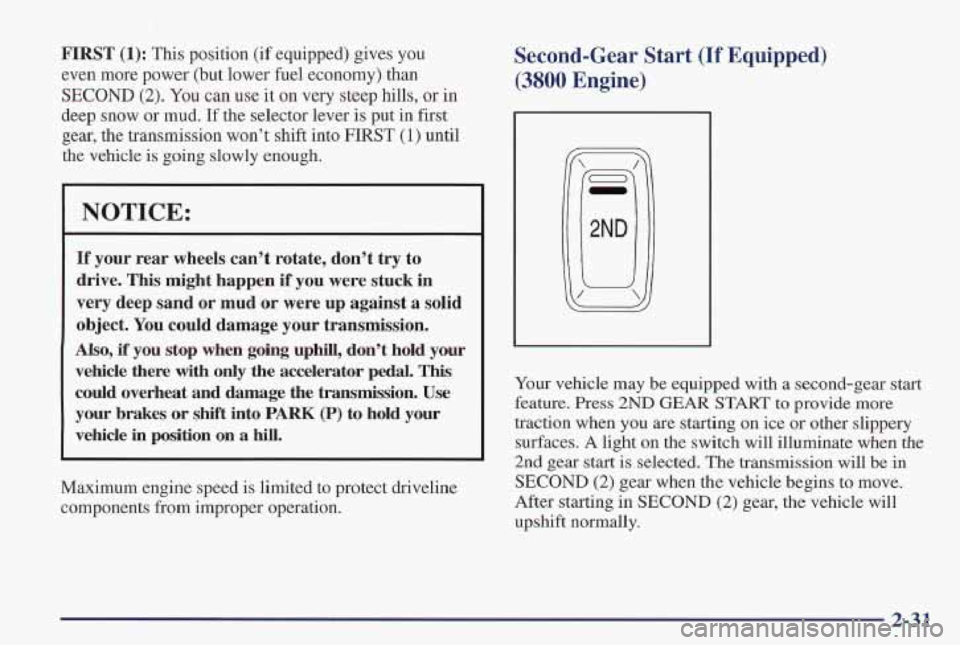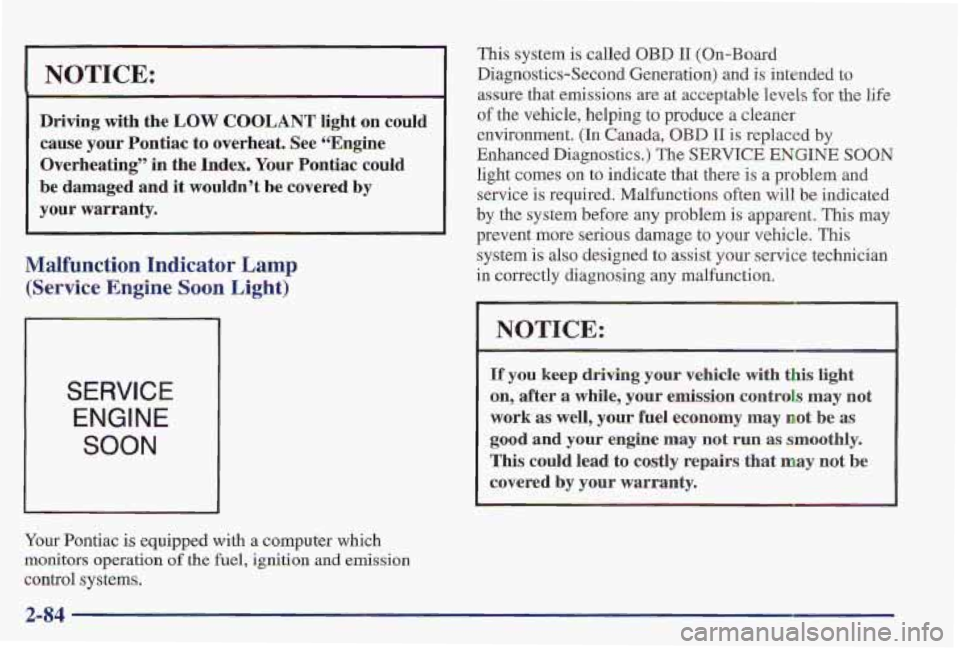engine overheat PONTIAC FIREBIRD 1997 Owners Manual
[x] Cancel search | Manufacturer: PONTIAC, Model Year: 1997, Model line: FIREBIRD, Model: PONTIAC FIREBIRD 1997Pages: 410, PDF Size: 19.2 MB
Page 2 of 410

The 1997 Pontiac Firebird Owner’s Manual
1-1
2-1
3-1
4-1
5-1
6-1
7-1
8-1
Seats and Restraint Systems
This section tells you how to use your seats and safety belts\
properly. It also explains the “SRS” system.
Features and Controls
This section explains how to start and operate your Pontiac.
Comfort Controls and Audio Systems
This section tells you how to adjust the ventilation and comfo\
rt controls and how to operate your audio system.
Your Driving and the Road
Here you’ll find helpful information and tips about the road\
and how to drive under different conditions.
Problems on the Road
This section tells what to do if you have a problem while driving, such as a flat tire or overheated engine, etc.
Service and Appearance Care
Here the manual tells you how to keep your Pontiac running properly and\
looking good.
Maintenance Schedule
This section tells you when to perform vehicle maintenance and \
what fluids and lubricants to use.
Customer Assistance Information
This section tells you how to contact Pontiac for assistance a\
nd how to get service and owner publications.
It also gives you information
on “Reporting Safety Defects” on page 8-10.
9-1 Index
Here’s an alphabetical listing of almost every subject in this manual. You can use it to quickly find
something
you want to read.
Page 76 of 410

Engine Coolant Heater (If Equipped) 3. Plug it into a normal, grounded 110-volt AC outlet.
Plugging the cord into an ungrounded outlet
could cause
an electrical shock. Also, the wrong
kind
of extension cord could overheat and cause
a fire. You could be seriously injured. Plug the
cord into a properly grounded three-prong 110-volt
AC outlet. If the cord won't reach, use a
heavy-duty three-prong extension cord rated for
at least
15 amps.
In very cold weather, 0°F (- 18 "C) or colder, the engine
coolant heater can help. You'll get easier starting and
better fuel economy during engine warm-up. Usually,
the coolant heater should be plugged in
a minimum of
four hours prior to starting your vehicle.
To Use the Coolant Heater
1. Turn off the engine.
2. Open the hood and unwrap the electrical cord.
4. Before starting the engine, be sure to unplug and
store the cord as it was before to keep it away from
hot pipes, manifold or any moving engine parts. If
' you don't, it could be damaged.
How long should you keep the coolant heater plugged
in? The answer depends on the outside temperature, the
kind
of oil you have, and some other things. Instead of
trying to list everything here, we ask that you contact
your Pontiac dealer in the area where you'll be parking
your vehicle. The dealer can give you the best advice
for
that particular area.
2-27
Page 80 of 410

FIRST (1): This position (if equipped) gives you
even more power (but lower fuel economy) than
SECOND (2). You can use it on very steep hills, or in
deep snow or mud. If the selector lever is put in first
gear, the transmission won’t shift into
FIRST (1) until
the vehicle is going slowly enough.
NOTICE:
If your rear wheels can’t rotate, don’t try to
drive. This might happen if you were stuck in
very deep sand or mud or were up against a solid
object. You could damage your transmission.
Also, if you stop when going uphill, don’t hold your
vehicle there
with only the accelerator pedal. This
could overheat and damage the transmission. Use
your brakes or shift into
PARK (P) to hold your
vehicle in position on
a hill.
Maximum engine speed is limited to protect driveline
components from improper operation.
Second-Gear Start (If Equipped)
(3800 Engine)
Your vehicle may be equipped with a second-gear start
feature. Press 2ND GEAR START to provide more
traction when you are starting on ice
or other slippery
surfaces.
A light on the switch will illuminate when the
2nd gear start
is selected. The transmission will be in
SECOND (2) gear when the vehicle begins to move.
After starting
in SECOND (2) gear, the vehicle will
upshift normally.
2-31
Page 87 of 410

I NOTICE:
Driving with the parking brake on can cause
your rear brakes to overheat. You may have to
replace them, and you could also damage other
parts of your vehicle.
If you are towing a trailer and are parlung on any hill,
see
“Towing a Trailer” in the Index. That section shows
what to do first to keep the trailer from moving.
Shifting Into PARK (P) (Automatic
Transmission Models Only)
It can be dangerous to get out of your vehicle if
the shift lever is not fully in
PARK (P) with the
parking brake firmly set. Your vehicle can roll.
If you have left the engine running, the vehicle
can move suddenly. You or others could be
injured.
To be sure your vehicle won’t move, even
when you’re on fairly level ground, use the steps
that follow.
If you’re pulling a trailer, see
‘(Towing a Trailer’’ in the Index.
2-38
Page 88 of 410

2.
3.
4.
Hold the brake pedal down with your right foot and
set the parking brake.
Move the shift lever
into PARK (P) position by
holding in the button
on the lever and pushing the
lever all the way toward the front
of your vehicle.
Move the ignition key to
LOCK.
Remove the key and take it with you. If you can
leave your vehicle with the ignition key in your
hand, your vehicle is in PARK (P).
Leaving Your Vehicle With the Engine
Running (Automatic Transmission
Models Only)
It can be dangerous to leave your vehicle with the
engine running. Your vehicle could move
suddenly
if the shift lever is not fully in PARK (P)
with the parking brake firmly set. And, if you
leave the vehicle with the engine running,
it could
overheat and even catch fire. You
or others could
be injured. Don’t leave your vehicle
with the
engine running unless you have to.
2-39
Page 130 of 410

Traction Control System Warning Light
(If Equipped)
I
Your regular brake system may not be working
properly if the anti-lock brake system warning
light is flashing. Driving with the anti-lock
brake system warning light flashing can lead to
an accident. After you’ve pulled off the road
and stopped carefully, have the vehicle towed
for service.
If the anti-lock brake system warning light stays on
longer than normal after you’ve started your engine, turn
the ignition off. Or, if the light comes on and stays on
when you’re driving, stop as soon as possible and turn
the ignition off. Then start the engine again to reset the
system.
If the light still stays on, or comes on again
while you’re driving, your Pontiac needs service. If the
light is on but not flashing and the regular brake system
warning light isn’t on, you still have brakes, but you
don’t have
anti-lock brakes.
The anti-lock brake system warning light should come
on briefly when you turn the ignition key to RUN. If the
light doesn’t come on then, have it fixed so it will be
ready to warn you if there is a problem.
TCS
OFF
This warning light should
come on briefly as you start
the engine.
If the. warning
light doesn’t come on then,
have it fixed
so it will be
ready to warn you if there’s
a problem.
If it stays on, or comes on when you’re driving, there
may be a problem with your traction control system and
your vehicle may need service. When this warning light
is on, the system will not limit wheel spin. Adjust your
driving accordingly.
If your brakes begin to overheat, the brake portion of the
traction control system will shut down, but the throttle
and engine spark control will continue
to work. The
warning light will not come on when this happens.
Page 132 of 410

Engine Coolant Temperature Gage
This gage shows the engine
coolant temperature.
If the
gage pointer moves into the
red area, your engine is too
hot! It means that your
engine coolant has
overheated.
Low Coolant Light (VS Engine)
This warning light should
come on while you are
starting your engine.
If the
light doesn’t
come on, have
it repaired.
If you have been operating your vehicle under normal
driving conditions, you should pull off the road, stop
your vehicle and turn off the engine as soon as possible.
In “Problems
on the Road,” this manual shows what to
do. See “Engine Overheating” in the Index. Your
Firebird is equipped with
a LOW COOLANT
indicator which is designed to detect when the coolant
level drops below set limits. If the low coolant level
sensor (on the radiator) drops while the engine is
running,
the LOW COOLANT indicator will light and
remain lit until the ignition switch
is turned to the OFF
position. Check coolant level and add coolant as needed.
The LOW COOLANT light might stay on after filling
the radiator. Turn the ignition switch to the
OFF
position, then restart the engine to verify that the LOW
COOLANT light goes out. See “Engine Coolant” in
the Index.
2-83
Page 133 of 410

NOTICE:
Driving with the LOW COOLANT light on could
cause your Pontiac
to overheat. See 66Engine
Overheating”
in the Index. Your Pontlac could
be damaged and
it wou1dn”t be covered by
your warranty.
Malfunction Indicator Lamp
(Service Engine Soon Light)
SERVICE
ENGINE
SOON
Your Pontiac is equipped with a computer which
monitors operation
of the fuel. ignition and emission
control systems. This
system is called
OBD I1 (On-Board
Diagnostics-Second Generation) and is intended to
assure that emissions are at acceptable levels
for the life
of the vehicle, helping to produce a cleaner
environment.
(In Canada, OBD 11 is replaced by
Enhanced Diagnostics.) The SERVICE ENGINE SOON
light comes on to indicate that there is a problem and
service
is required. Malfunctions often will be indicated
by the system before any problem is apparent. This may
prevent more serious damage
to your vehicle. This
system is also designed to assist your service technician
in correctly diagnosing any malfunction.
NOTICE:
If you keep driving your vehicle with this light
on, after
a while, your emission controls may not
work as well, your fuel economy may not be as
good and your engine may not run as smoothly.
This could lead to costly repairs that may not be
covered by your warranty,
2-84
Page 202 of 410

Driving On Grades Making Turns
I NOTICE:
Making very sharp turns while trailering could cause the trailer to come in contact with the
vehicle. Your vehicle could be damaged. Avoid
making very sharp turns while trailering.
When you’re turning with a trailer, make wider turns than
normal. Do
this so your trailer won’t strike soft shoulders,
curbs, road signs, trees or other objects. Avoid jerky or
sudden maneuvers. Signal well in advance.
Turn Signals When Towing a nailer
The green arrows on your instrument panel will flash
whenever you signal a turn or lane change. Properly
hooked up, the trailer lamps will also flash, telling other
drivers you’re about to turn, change lanes or stop.
When towing a trailer, the green arrows on your
instrument panel will flash for turns even if the bulbs on
the trailer are burned out. Thus, you may think drivers
behind you are seeing your signal when they are not. It’s
important to check occasionally to be sure the trailer
bulbs are still working. Reduce
speed and shift
to a lower gear before you start
down a long or steep downgrade. If you don’t shift
down, you might have to use your brakes
so much
that they would get hot and
no longer work well.
On a long uphill grade, shift down and reduce your
speed to around
45 mph (70 km/h) to reduce the
possibility
of engine and transmission overheating.
If you are towing a trailer and you have an automatic
transmission with overdrive, you may prefer to drive in
THIRD
(3) instead of AUTOMATIC OVERDRIVE (a)
(or, as you need to, a lower gear). Or, if you have a
manual transmission with FIFTH
(5) or SIXTH (6) gear
and you are towing a trailer, it’s better not to
use FIFTH
(5) or SIXTH (6) gear. Just drive in
FOURTH
(4) (drive in FIFTH (5) if you have a
six-speed manual transmission) or, as you need to,
a lower gear.
4-37
Page 206 of 410

Section 5 Problems on the Road
Here you’ll find what to do about some problems that can occur on the road.
5-2
5-3
5-8
5-14
Hazard Warning Flashers
Jump Starting
Towing Your Vehicle
Engine Overheating 5-26 If a Tire Goes Flat
5-26 Changing a Flat Tire
5-38 Compact Spare Tire 5-39
If You’re Stuck: In Sand, Mud,
Ice or Snow
5-1